
The Ever Expanding History of the Front Load Refuse Truck
1980-Present: Shapes of Things to Come

California-based C & O (left) was bought by Dempster, essentially becoming an autonomous western division.
2002 Dempster DM2 (right) represents the final model from this one-time industry leader
For some companies, the 1980s saw a continuation of the same success the previous ten years had brought. Many had strong and dependable reputations, while others were still new and trying to establish their own. Still, the deep recession of the 1970s did not leave the refuse industry untouched, with national business bankruptcies rising to over 50 percent from previous years. Harsco Corporation, parent company of Cobey, closed down their refuse line and sold the truck designs to Athey Products in North Carolina. The Cobey refuse line remained relatively unchanged under the Athey badge, but by the close of the 80s both the front and rear load lines were cancelled. Another company with clouds on the horizon was Dempster, which was sold for a second time to Technology Incorporated, a company which traded as Krug International. California builder C&O was absorbed shortly after, and served as Dempster's western headquarters. During a 1987 strike, Krug International permanently closed the Knoxville factory, abruptly ending over fifty years of production in that city. Dempster's eastern operations were moved south to Toccoa, Georgia and in the early 1990s, the ownership was transferred yet again to Toccoa Metal Technologies. They changed the name to Dempster Inc. and continued to build refuse equipment for another fifteen years under this badge. Despite a last ditch effort to rescue the company by outside investors, Dempster collapsed under the weight of its mounting debt in 2003. Once a leader in commercial refuse systems, the company had become a shell of its former self and disappeared without great fanfare.
Sargent Industries folded Gar Wood forever in 1979, electing to license their patented refuse bodies around the world. In the United States, Heil opted for the Smith-designed rear loader, which became the Heil Formula 5000 and eventually became their all-time best seller. The old Gar Wood front loader is rumored to have also been reincarnated briefly by Heil, but corroboration of this has not been forthcoming. Ultimately, the Gar Wood front loader design went on to new life in Europe, primarily through FAUN, who still produce it in Germany as the FrontPress. Aspinwall Engineering also built a copy for the UK market, even carrying the Gar Wood nameplate through 1993. Among the eastern builders, Both Heil and E-Z Pack introduced their first-ever half-pack models for 1986, both equipped with Amrep-inspired cross-ram packing cylinders. E-Z Pack broke the most new ground with their Hercules Half-Pack, the first front loader with a true curved shell body. The sidewalls were formed from a single, broad radius sheet with no support ribs. A perimeter box was the only reinforcement used. This construction was pioneered by Fred Smith for Sargent in the 1970s, but had heretofore only seen regular production on a rear loader, the ill-fated Gar Wood Ten Hundred.
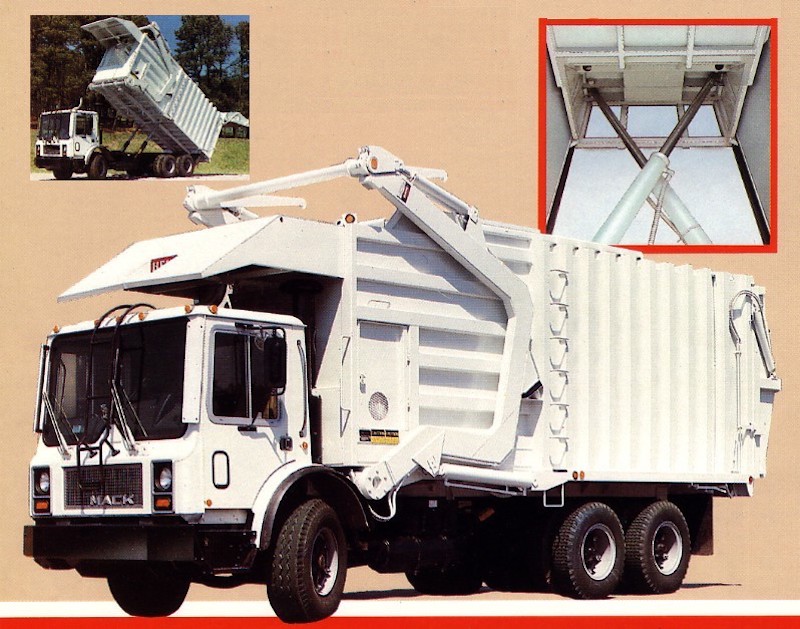
1986 Heil Half-Pack showed heavy west coast influence, including "cross-ram" packing cylinders
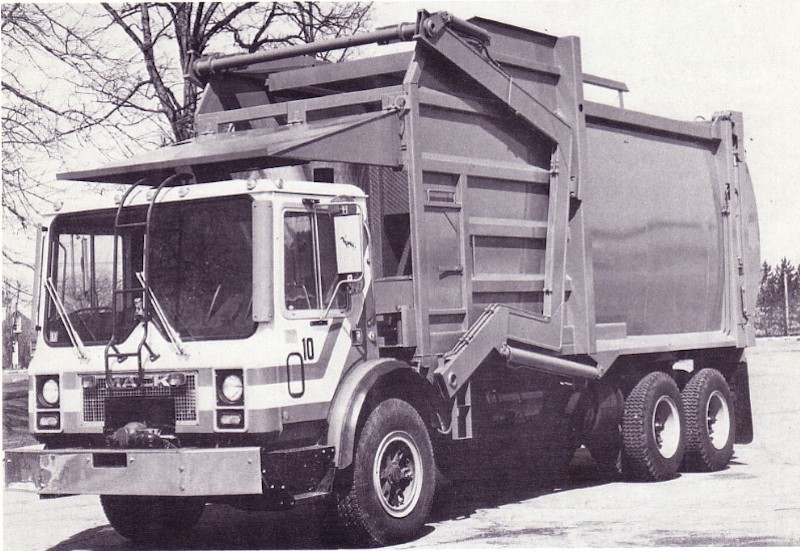
E-Z Pack Hercules also arrived for '86, with industry-first curved-shell front loader
By 1980, Maxon had dropped the Bemars and Western names in an effort to establish their own identity, and integrate their lineup. They took the expertise learned from those acquisitions and quickly grew to be on par with Bowles as a major SoCal builder. Maxon's new lightweight Eagle series, sold as a complete refuse truck, was available as a side or front loader. Maxon also began aggressively marketing their product nationwide, and made some decent inroads to the east, particularly with their side loader. By 1985 they had patented an octagonal style half-pack body that in a few short years became one of the most popular styles in the Western United States. For reasons still unknown, Maxon decided to suspend their refuse line in the 90s, and closed their manufacturing facility in Los Angeles, focusing on their successful tail gate lifts which are popular today on many delivery trucks.
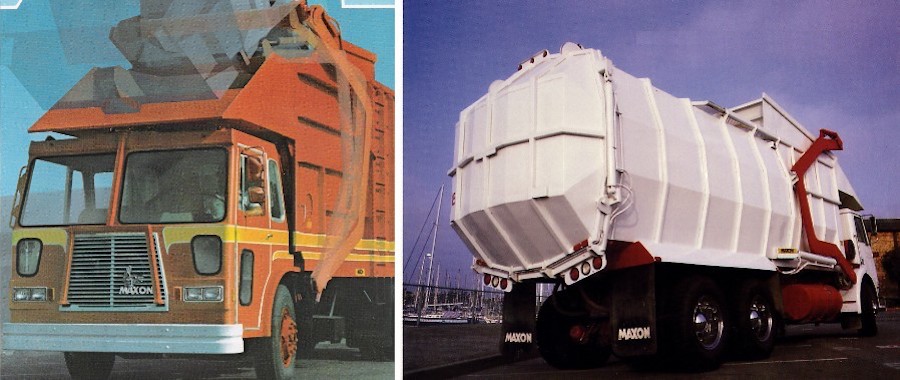
Left: In addition to refuse bodies, Maxon introduced a complete refuse truck called the Eagle, starting in the late 1970s. These were
route-ready cab-chassis-packers, in side or front load configuration Right: The spectacular Maxon Legal One octagonal front loader body
Amrep continued to grow and prosper in the early 80s, building trucks for many of the bigger Los Angeles area haulers and municipalities. They patented their own octagonal front loader in 1984, using their scissor-style packing system with a "quarter-pack" blade. Unlike the Top Pack design where the blade is located at the top of the body, the new Amrep blade was located on the bottom of the hopper. This necessitated the addition of a follower plate, which retracted into the bottom of the cab shield to prevent material from falling behind the blade during the packing cycle. Once again, Amrep had brought an advanced new design to the industry. Surprisingly, this one never really took root outside of the SoCal market, where customers favored its lightweight design and ability to load trash while simultaneously packing. Amrep still offers this octagonal front loader with either a quarter, half, or full pack configurations.
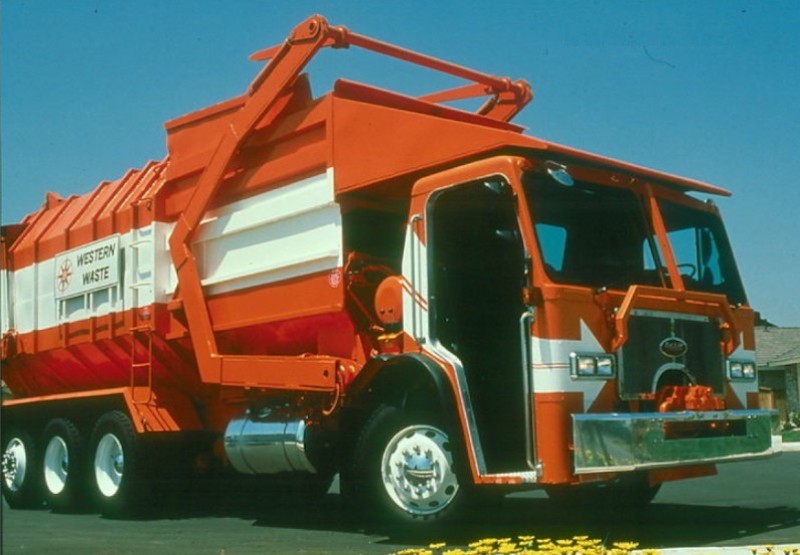
Amrep Octo front loader combined beauty and functionality, the quintessential California refuse truck of the 1980s
The last serious attempt to radically change the front loader came in 1984 from Crane Carrier Corporation (CCC) of Tulsa, Oklahoma. CCC was mostly known for their Centurion cab & chassis, designed specifically for the refuse industry. Their Integrated Front Loader (IFL) was a "chassisless" truck, merging the body and chassis into one structure with a mid-mount engine and rear wheel drive. The IFL also featured the first new container lifting equipment attempted since 1957. The radical design used twin rigid lift arms, curved to span the cab from the bumper to the top of the body. As the arms were lifted almost straight up, they pivoted at their upper ends through short links, while the lower ends followed corresponding rail guides. Upon reaching roof level, then container was tilted inward in the conventional manner on a pivoting shaft. A futuristic 47-cubic yard cylindrical body yielded tremendous strength with little reinforcement. Dead space in the body was minimized by locating the packing cylinder over the cab, eliminating the protrusion into the packer plate and angled blades common to traditional front loaders. In some ways, the IFL was the truck Gar Wood had tried unsuccessfully to create with the T-series two decades earlier. Practical engineering, which avoided the difficulties associated with front wheel drive and the use of industry-standard side fork coupling saved it from the fate of its predecessor. The IFL enjoyed moderate success in the Midwest and East Coast market during its respectable fifteen year run. It spawned rear and side load counterparts before being discontinued by the end of the 1990s.
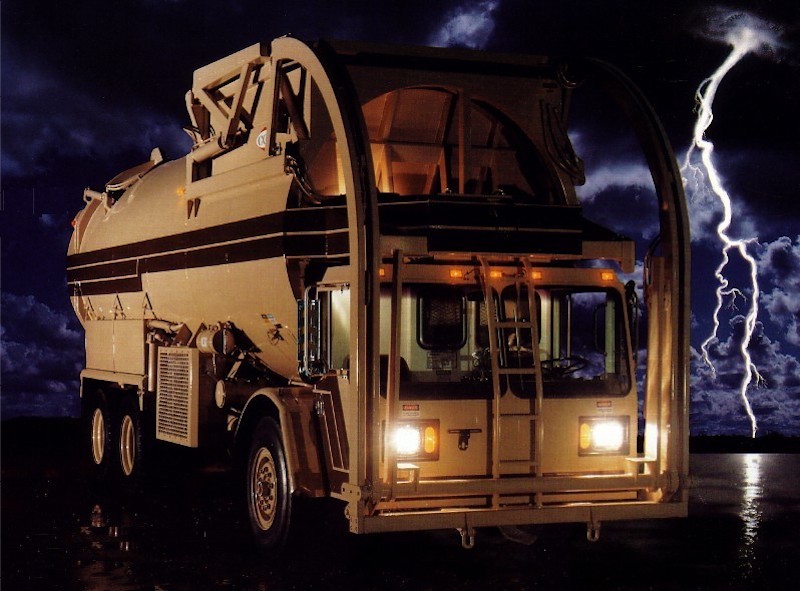
Shapes of things to come: The futuristic-looking CCC Integrated Front Loader was a traffic-stopper
Vincen Bowles, pioneer of the front loader, had dropped his pull-type packer from regular production in favor of the traditional push-type cylinder placement, though a few haulers in the area still favored it. He had also introduced his second generation "horizontal brace" front loader in the mid 1970s, featuring a very basic bracing scheme. Instead of narrow vertical ribs that ran down the length of the square body, two wide box-like braces ran down the length intersected by a vertical brace that separated the hopper and body. Bowles was visited by Claude Bovian, the owner of Quebec-based Labrie Equipment Ltd. in 1984. Bovian was looking to manufacture a front loader in Canada, and secured the rights to build the Bowles horizontal-brace design. Around this time, in his continuing effort to offer the best body on the market, Bowles designed a front loader with a cylindrical body, much like that of a steam locomotive. This "boiler" design was not a new sight in the refuse industry, having been used on side loaders since the mid 1940s. But the new Bowles, along with Crane Carrier's IFL, was among the first to use circular construction on a front load packer since 1955, when Dempster had used modified Pak-Mor bodies for the original Dumpmaster. The result was a super-lightweight body with a high strength, yet using a thinner gauge steel. Unlike the Crane Carrier packer, Bowles used twin cross-ram packing cylinders as were becoming common during this time. The cylindrical front loader would be the last new body design to come off of Bowles' drawing board, as his health had begun to deteriorate.
In 1984, Vincen Bowles suffered a heart attack, followed by two strokes a few years later in 1989, leaving him without the ability to speak. In 1992, Samuel Vincen Bowles passed away at the age of 82. It is hoped that the contributions made by Bowles to the waste hauling industry will someday be fully appreciated. A mechanical engineer whose designs revolutionized the collection of commercial refuse, Bowles' early front loaders became the first fully automated refuse trucks in the world and helped the industry realize the full potential of a detachable container on a multiple-stop collection route. Once mostly a California phenomenon, his half pack body eventually caught-on in an increasingly weight-conscious national industry some thirty years after the original design hit the streets in 1955. If one person could be called the "Father of the Front Loader," S. Vincen Bowles would certainly be that man.
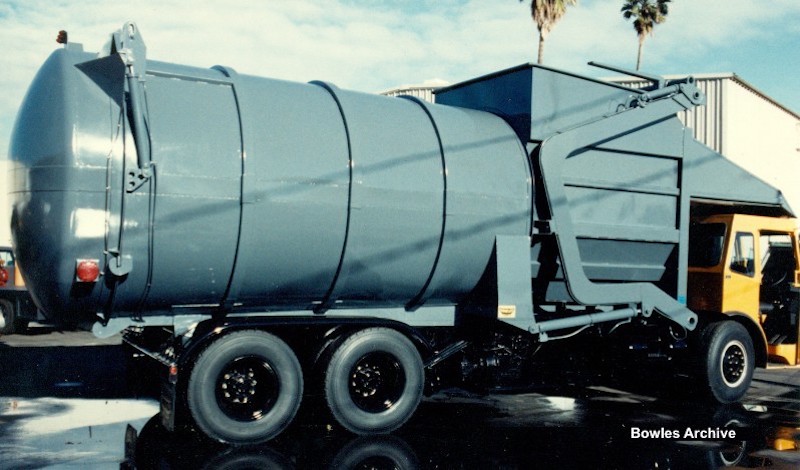
S. Vincen Bowles last design was this circular front loader with outstanding strength-to-weight ratio
1990-Present: The Culmination of Design
By the 90s an industry standard front loader had unofficially been established and included the over-the-cab arms, with direct-pull lift cylinders located on the outside of the body, and either a half-pack or full-pack blade. Full-pack trucks were still a favorite of east coast haulers who were not affected by strict weight laws, while the half-pack body was marketed to the western states. However, the half-pack was being seen more and more in the east, being adopted by Heil, E-Z Pack and a new company to the front load field called McNeilus. Also taking root in this period were cross-ram or scissor style packing rams, pioneered by Amrep in California, which were being used on front load loader from coast-to-coast. Welding and better manufacturing techniques continued to be developed, and curved-shell bodies with bubble tailgates became the norm. The old ribbed, flat-sided bodies soon became a relic of the past. Cable-driven controls had given way to "air-over-hydraulics" and ergonomic joysticks, with the focus on driver comfort and simplicity of operation becoming a major company selling point.
Waste companies had always been bought and sold in the competitive American economy, but the mid-20th century had been the apex of small private haulers throughout the United States. Often these small "mom-and-pop" companies would purchase trucks from the same truck builders, creating decades-long personal relationships, where your word and a handshake were considered a binding contract. Through this, a builder's customer base was often built through the reliable word of mouth advertisement. As more waste haulers started trading on the open stock market in the latter half of the century, a wave of buyouts of private companies led their efforts to expand territory. Another factor that contributed to the rise the large waste haulers was that many cities and counties were becoming franchised in an effort to drive down costs. With haulers now having to bid for their contracts, many ended up selling their businesses because they could not compete in this changing market. While the number of haulers across the nation dwindled, so did the customer base for refuse equipment. The days of customers ordering one or two trucks a year were gone, replaced by massive fleet orders by national concerns. The smaller builders didn't have the resources to competitively bid against their larger counterparts, forcing most to close their doors.
With the turn of the century looming, some of the larger truck builders that had been around for decades merged with foreign companies in an effort to boost their finances to keep ahead of the competition. Heil Company was acquired by the Dover Corporation in 1993 ending almost 90 years of family ownership while broadening their European footprint. Under the umbrella of Oshkosh Corporation, upstart McNeilus powered their way into the industry with massive fleet sales to companies such as BFI, and is now one of the top producers. The Leach Company, family owned since 1887, began selling its shares to Federal Signal Corporation in 2002 with the transaction complete by the next year. Their successful rear load refuse line was moved from Oshkosh, Wisconsin to the recently acquired Wittke facility up in Alberta, Canada in 2004, while the rest of Leach's products were discontinued. Under Federal Signal, the Leach rear load line was updated with a curved shell body and the Wittke front loaders were produced under the Leach badge, having secured a lucrative contract with Waste Management Inc. However, only a year later Federal Signal was fed up with the refuse industry, and sold the entire refuse line to Labrie Environmental by 2006. Labrie re-organized their company, dropping their own front load body in favor of the well-known Wittke brand. Along with this latest acquisition they had also secured the license to use Hardox, a lightweight steel which allowed the entire side of the truck to be made with a single sheet of metal, versus welding several pieces together which caused weakness in the body and increased weight.
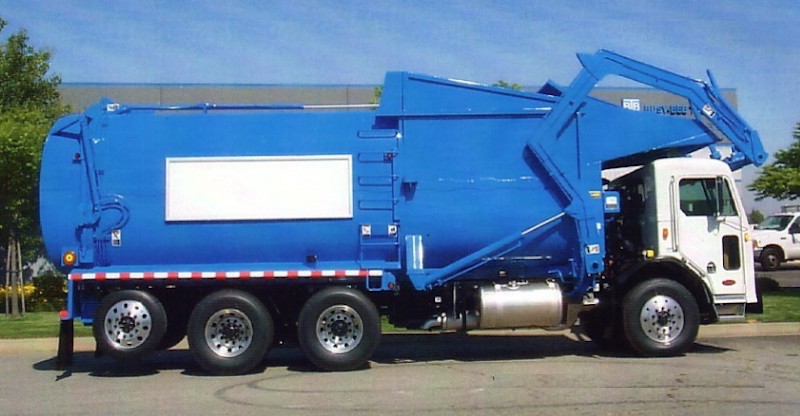
Modern Amrep front loader features elliptical body made from Hardox high-strength steel
From its humble beginnings as an open body dump truck with rigid arms and conventional truck chassis, front loaders have evolved today into a high-compaction, operator-friendly vehicle, offering an effective method for companies to handle both their residential and commercial accounts using a fully automated truck. The options refuse companies now have available for their front loaders are endless. They have the ability to see and record individual customers' trash weights through the use of on-board scales, and accurately depict the gross vehicle weight to prevent going over legal limits. With cameras mounted around the body feeding images into a monitor inside the cab, the operator can have a 360-degree situational awareness of potential dangers and obstacles, reducing safety incidents across the board. Residential "carry buckets" have evolved, now sporting fully automated cart dumpers for one-man operation.
2012 marks the 60th anniversary of the Front Loader refuse truck. It has changed the way we store, collect and haul refuse more than any other design in industry history. Even the ultra-modern Automated Side Loader, the vanguard of collection technology, evolved from the front loader. In reconstructing its history, we have in place many pieces of the puzzle, but there is much that is still unknown about smaller body builders, especially in the Southern California region. Often building exclusively for one or two haulers, there was no need to advertise their product, leaving little trace of their existence today. Only the recollections of individuals that have worked in the industry remain as their testament. owing to the nature of their work, old refuse trucks are rarely preserved, and quite often worked to the point of resembling nothing more than welded scrap metal. Every truck, hauler, manufacturer, and driver has a story. By leaving no stone unturned in our quest for answers we may, someday, finally have a complete picture of the people and trucks that forever changed the waste industry.


5/12/12
© 2012 Zachary Geroux and Eric Voytko
All Rights Reserved
Photos from factory brochures/advertisements except as noted
Logos shown are the trademarks of respective manufacturers
|
|